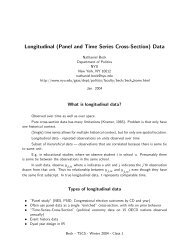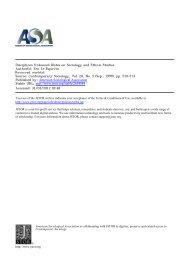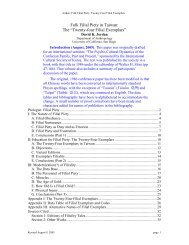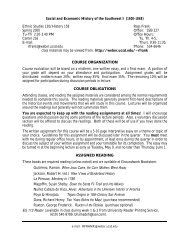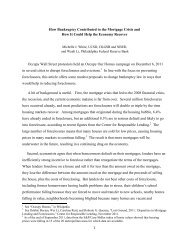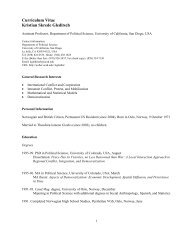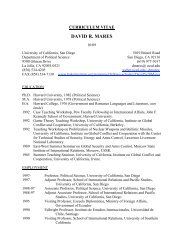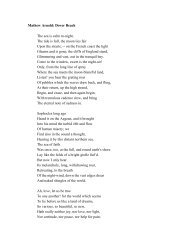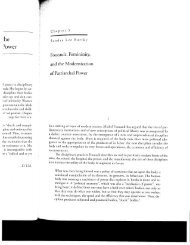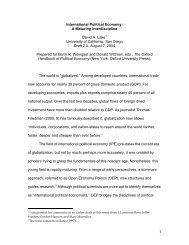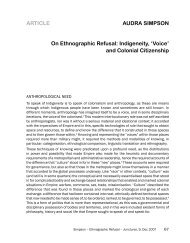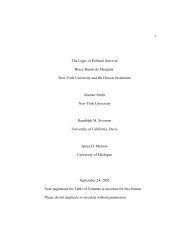Climate change and water resources in the Murray Darling Basin ...
Climate change and water resources in the Murray Darling Basin ...
Climate change and water resources in the Murray Darling Basin ...
You also want an ePaper? Increase the reach of your titles
YUMPU automatically turns print PDFs into web optimized ePapers that Google loves.
ABARE CONFERENCE PAPER 02.11<br />
Water dem<strong>and</strong><br />
Irrigated agriculture generates <strong>the</strong> largest consumptive dem<strong>and</strong> for surface <strong>and</strong> ground<br />
<strong>water</strong> <strong>resources</strong> <strong>in</strong> <strong>the</strong> <strong>Murray</strong> Darl<strong>in</strong>g Bas<strong>in</strong>. Around 10 000 gigalitres of surface <strong>water</strong><br />
is diverted for irrigation <strong>in</strong> <strong>the</strong> <strong>Murray</strong> Darl<strong>in</strong>g Bas<strong>in</strong> each year (MDBC 2002). While <strong>the</strong><br />
availability of <strong>water</strong> for irrigation is likely to decrease under conditions of reduced precipitation<br />
<strong>and</strong> <strong>in</strong>creased evapotranspiration, it is uncerta<strong>in</strong> how sensitive agricultural <strong>water</strong><br />
dem<strong>and</strong>s will be under enhanced greenhouse conditions. There are compet<strong>in</strong>g effects.<br />
First, decreased precipitation may lead to lower soil moisture profiles dur<strong>in</strong>g <strong>the</strong> irrigation<br />
season, depend<strong>in</strong>g on <strong>the</strong> tim<strong>in</strong>g of <strong>the</strong> ra<strong>in</strong>fall <strong>and</strong> <strong>the</strong> <strong>water</strong> hold<strong>in</strong>g capacity of <strong>the</strong><br />
soil. Second, <strong>in</strong>creases <strong>in</strong> potential evaporation through, for example, <strong>in</strong>creased temperature<br />
or reduced humidity, is likely to <strong>in</strong>crease losses from irrigation storages <strong>and</strong> channels.<br />
However, as noted previously, <strong>in</strong>creased atmospheric concentrations of carbon dioxide<br />
can lead to higher efficiency of plant <strong>water</strong> use, reduc<strong>in</strong>g <strong>the</strong> level of irrigation required<br />
to obta<strong>in</strong> a given yield.<br />
Case studies <strong>in</strong> <strong>the</strong> United States have produced some conflict<strong>in</strong>g results. In a climate<br />
<strong>change</strong> scenario <strong>in</strong>vestigated by Hatch et al. (1999), irrigation requirements were estimated<br />
to fall by as much as 30 per cent for corn <strong>in</strong> <strong>the</strong> south east United States. However,<br />
Ritschard et al. (1999) explored <strong>the</strong> same scenario <strong>and</strong> estimated that irrigation <strong>water</strong><br />
requirements would <strong>in</strong>crease. These studies <strong>in</strong>dicate <strong>the</strong> considerable uncerta<strong>in</strong>ty about<br />
future dem<strong>and</strong> for irrigation <strong>water</strong> <strong>and</strong>, hence, irrigation abstractions under conditions of<br />
enhanced global warm<strong>in</strong>g (Arnell <strong>and</strong> Chunzhen 2001).<br />
Water quality<br />
<strong>Climate</strong> <strong>change</strong> has <strong>the</strong> potential to make a significant impact on <strong>water</strong> quality <strong>in</strong> <strong>the</strong><br />
<strong>Murray</strong> Darl<strong>in</strong>g Bas<strong>in</strong>. As much of <strong>the</strong> cont<strong>in</strong>ent was covered by an <strong>in</strong>l<strong>and</strong> sea several<br />
millions of years ago, sal<strong>in</strong>e ground <strong>water</strong> systems are part of Australia’s geological legacy.<br />
Consequently, more than 25 per cent of Australia’s accessible ground <strong>water</strong> is above 1500<br />
milligrams of salt per litre (mg/L) <strong>and</strong> more than 10 per cent is <strong>in</strong> excess of 5000 mg/L<br />
(National L<strong>and</strong> <strong>and</strong> Water Resources Audit 2000). In irrigation areas along <strong>the</strong> south west<br />
reaches of <strong>the</strong> <strong>Murray</strong> River, ground <strong>water</strong> sal<strong>in</strong>ity levels are <strong>in</strong> excess of 30 000 mg/L,<br />
close to <strong>the</strong> salt concentration of sea<strong>water</strong>.<br />
Ris<strong>in</strong>g river sal<strong>in</strong>ity is a major <strong>water</strong> quality issue <strong>in</strong> <strong>the</strong> <strong>Murray</strong> Darl<strong>in</strong>g Bas<strong>in</strong>. L<strong>and</strong> clear<strong>in</strong>g<br />
<strong>and</strong> irrigation have <strong>in</strong>creased ground <strong>water</strong> recharge, which over time has led to ris<strong>in</strong>g<br />
<strong>water</strong> tables <strong>and</strong> <strong>in</strong>creased discharge of sal<strong>in</strong>e ground <strong>water</strong> <strong>in</strong>to rivers <strong>and</strong> streams.<br />
Consequently, <strong>the</strong> deterioration of river health ow<strong>in</strong>g to <strong>in</strong>creas<strong>in</strong>g sal<strong>in</strong>ity has been a<br />
concern to state <strong>and</strong> federal governments over recent years.<br />
11




